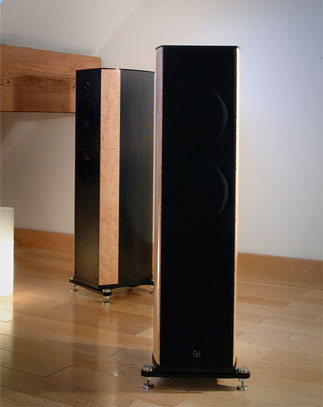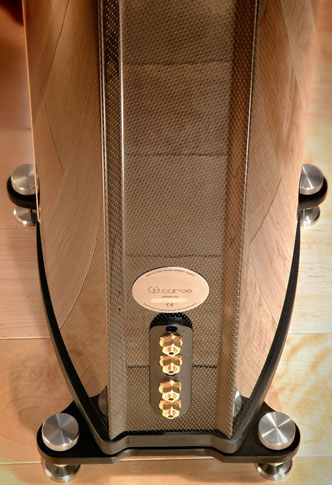“I was trying to set the carbon fiber cabinet on fire…” That was the excuse I handed the officer when I was arrested for playing my system in excess of the posted decibels. My fine was $375.00 and 21 days of silence. I chose to pay the fine rather than run the risk of having the authorities impound my stereo.
If I were to write a fictional book on the excesses of an audiophile, the Wilson Benesch Curves could play a part in it just as sports car exotica adorn the lifestyles of the wretchedly rich. My scenario sends shudders down my spine; what a hellish world it would be if we could not “open up” our systems and let them run “full throttle” from time to time – not to the point of damage, of course, but to hear them in all their open-throated glory!
I am an acquaintance to a couple who own a Saleen S7 supercar. It’s nice. Disgustingly nice, sleek, fast, powerful and eye-popping to those who will never own one. The husband had postcards made to hand out to gawkers. It’s made for speed, with little appreciation given to the creature comforts that most sedan drivers enjoy every day. I have to laugh at the inaccurate perception most have of what it is like to own such a vehicle. Cars like the Saleen elicit envy on many levels. However, the truth of ownership is far from the perception.
This particular couple attempted once to take their high speed baby on a road trip to Detroit for a car show. Big mistake – the ride was intolerable; the cabin was so cramped and noisy (remember, this is car has a 7.0 liter V8 with 750 horsepower sitting right behind the driver and passenger), the suspension so stiff and the seating so hard that they have never taken it out for more than a short spin since! Looking on the Saleen website at the “cutaway” computer image shows that half the car is engine! It’s for performance and looks, comfort be damned.
Could the Wilson Benesch Curves be called a Superspeaker, in the tradition of the finest and “fastest” speakers in the world? And just because technologies employed in the making of an F1 car are utilized on the Curve, does that mean it yields super-sonics? It bears further investigation, especially by those who are seeking superb performance in a smaller floor standing speaker.
It takes a very strong philosophy of car design to make a Saleen, and it takes a very strong perspective on speaker design to produce the Curve speaker. As I explored the curves I encountered that strong perspective and had to weigh the judgments that Wilson Benesch has made in regard to their speakers. Because of the decisions they have made in producing this speaker, would it be one for the masses, or would it be a niche product with exquisite performance but some real world limitations? A lengthy test drive was in order.
Considering the appearance of the Curve, the carbon fiber body gets me thinking of the Saleen. “Isn’t this a bit excessive,” my mind queries? With its sleek lines and glancing appearance, the speaker is well named, and seductive looking. The technology under its skin certainly hearkens toward a supercar. Consider that the cabinet is made from a variety of steel and aluminum alloys. The combination of several materials creates a “less audible structure as there is no single resonant frequency,” according to Craig Milnes, the principle designer of the Curves. In addition, each material was selected on the basis of its ability to control resonant energy, and the use of metals takes the resonant frequency above the most sensitive regions of human hearing.
The strength and stiffness of the materials allow for proportionately more air space inside the cabinet compared to traditional MDF structures. These metallic internals are then damped with lossy adhesives, presumably to halt metallic “ringing”. As a result, the speaker can be kept at more modest dimensions and
still produce plenteous bass. A “cabon fibre monocoque” shell with thinner, highly polished wood trim on the sides completes the over-the-top engineering effort.
Sporting a seductive woven pattern reminiscent of some golf club shafts as seen in the sunlight, the woven patterned gray composite which comprises the bulk of the exterior is engaged for energy absorption. Craig suggested just as the carbon fiber in a F1 car absorbs impact, so the carbon fiber in the Curve, “…is beyond anything else in terms of absorption.” Craig shared about the cabinet, “…its low mass enables the time delayed storage and re-emission of sound that is typical of high mass structures.” There’s an engineering principle in there somewhere that evades me, but I think the idea is that the stiffness of the more petite cabinet allows them to sound equivalent to larger, bulkier speakers. At least, when I listen to the Curves that’s what it sounds like to me.
Casting a glance at the Curve’s cast metallic cabinet, its aesthetics demand comment. Cabinet materials don’t come much more solid, nor cool as in harsh looking, than cast metal. In recent years, the use of cast aluminum for a speaker cabinet has become less an oddity and more an option. Krell’s LAT series has helped to raise awareness, and the home theater crowd has Definitive Technology making skinny aluminum towers. Vienna Acoustics’ Schonberg is also quite striking in appearance. Contrasting these, Wilson Benesch has chosen to hide the aluminum frame, possibly to avoid the strongly industrial appearance which is unavoidable in the metal finish. My hunch is that most refined rooms would clash with an Arnold Schwarzenegger Terminator-like speaker, and that W.B. wanted the performance of the metal with none of the decorative drawbacks.
The Curves are not large speakers, standing just over 36” tall, but their sound is prodigious for a speaker with such a small footprint. Their fit and finish is impeccable, the company showing class in everything from the easy open shipping crates to inclusion of crescent wrenches for assembling spikes and tightening speaker terminal nuts, as well as jumper cables with gold plated spades. The binding posts oriented vertically along the back spine of the cabinet near the bottom were a welcomed feature; they were easy to use, and being placed lower on the speaker, allow both more length to the speaker cable and keep it draped lower to the floor.
I appreciated the elegance in form and function of the unibody cabinet with its sprouted aluminum legs that accommodate massive adjustable spikes. Having set up the speakers on my carpeted flooring with all four spikes, I sensed the soundstage was a bit low and the tweeter beamed the high frequencies directly at my ears. I attempted to adjust the spikes to lean the speakers back, but found that there was not enough vertical travel to affect the desired rear tilt. To supply additional rear lean, I simply removed the back spikes and let the aluminum legged frame rest on the carpet. This tilted the speakers back enough to raise the soundstage, get the top-end slightly out of my ears and present a taller sound field. It worked marvelously, and the casual observer would not notice the disappearance of the rear spikes.
The road that led to the Curve is not a long one. Wilson Benesch began in 1989 with the financial support of the British Department of Trade and Industry. The first products were a carbon fiber sub chassis turntable and a high tech carbon fiber tonearm. With the benefit of hindsight, the reader can see where this was heading. WB displayed the world’s first curved carbon fiber loudspeaker design at the Frankfurt High End Show in 1995.
The next turn for WB was the development of the A.C.T. One speaker. It has a sloping top to reduce room interactions, a curved composite structure based upon carbon fiber, and a solid metal baffle to mount the drive units. Emphasis was placed upon phase coherence. This speaker garnished awards in Germany and Japan.
Following up in 1996 with another government matching grant, WB started development of an “advanced dynamic drive unit,” which ultimately became the “Tactic” drive. Otherwise referred to as an “Isobaric Tactic” system, it is essentially a Formula 1-quality speaker cone. As Craig shared, “it relates to a technology…a woven structure that exhibits damping at the molecular level when subjected to audio energy in the audible spectrum. (It is) several times stiffer than polypropylene and comparatively superior to all known materials when measured.” The culmination of this research was a speaker system called the “Bishop”, a four-
Tactic-driver speaker which was a non-commercial design, and the A.C.T. One system, which is at the pinnacle of the WB residential line. The Curves are a more petite “carbon copy” of the A.C.T. One system.
When a designer has a passion and a vision, he will pursue it to its end, precisely what Craig Milnes is doing with the Curves. WB is not afraid to go against the traffic of current trends. In talking with Craig, I got the sense that WB feels speaker manufacturers are making a trifecta of errors in speaker building, namely the use of physical time alignment, larger drivers and three way designs.
Against the popular school of designers who are using physical time alignment of drivers, WB has sworn off the practice, claiming, “Off setting the drivers causes more distortion than it attempts to reduce.” Answer to the time alignment problem, WB uses no crossovers with their Tactic drivers. When I asked precisely what “true linear phase” meant, Craig responded, “The term relates to the absence of crossover components, and as a result no voltage current out of phase anomalies.” So, it seems the system is composed of two full range 7” drivers tuned in the cabinet and a tweeter. I had to run that comment down a bit further.
- (Page 1 of 2)
- Next page →


